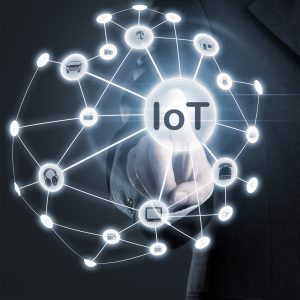
Businesses are moving beyond basic applications to use IoT to better manage key business processes, such as their end-to-end supply chain.
Businesses worldwide are moving full steam ahead with their Internet of Things (IoT) implementation. Recent research from Gartner indicates this industry momentum isn’t going to slow down anytime soon in the enterprise, as the analyst firm forecasts that the enterprise and automotive IoT market alone will grow to 5.8 billion endpoints in 2020, up from 4.8 billion expected by the end of 2019. And IDC says worldwide IoT spending will maintain a double-digit annual growth rate and surpass the $1 trillion mark in 2022.
One application that is enabling this growth, especially in enterprise environments like warehouse, retail, supply yards, healthcare facilities, and many others, is the ability to determine the accurate location of people and things as they move from place to place. Companies are becoming increasingly sophisticated in their understanding of IoT as a whole, and more specifically, what it can do for their business. As such, they’re growing their implementations significantly, moving beyond basic applications such as simple tracking of an object to use the IoT to better manage key business processes, such as their end-to-end supply chain. By understanding the precise location of a person or object by itself and in relation to other “things,” organizations are able to tackle everything from inventory control in a warehouse environment to understanding the specific path of healthcare workers to ensure that hygiene protocols are being met.
See also: AoA and AoD: Real-Time Location Services Drive IoT Value
Of course, everyone wants “accurate” location capabilities, but the definition of accuracy varies from company to company—and use case to use case. How accurate is accurate enough? One meter? 10 centimeters? There are a few distinct levels of accuracy and several technologies and methodologies by which each level can be achieved. Understanding each use case for which location is required, and what the short-term and longer-term location needs are for that application, are critical to determining which level is needed for which application. Determining total cost of ownership (TCO) of the end-to-end solution will be critical to making the correct decision.
Many different organizations can utilize location as a key business enabler, but it makes sense to look at the three levels of location accuracy across a single environment to show the benefits and use cases the different levels of location can enable. In this case, a warehouse is a good example to showcase exactly what location means for specific applications.
There are three general levels of location accuracy: Presence, Proximity, and Positioning:
Presence: Is an object present or not? Determining this is the goal of presence-based solutions.It’s a simple calculation compared to the other levels, and, unfortunately, it’s also the least accurate location level. In a warehouse environment, presence detection is commonly used to determine whether specific goods have arrived.Using an advanced location system using Bluetooth™ technology and the angle of arrival (AoA) methodology,organizations can placea locator at the entrance of the warehouse. As a tagged item passes through this “gate,” the system identifies the tag based on its unique ID, measures the angle of its signal, and calculates the direction of motion to determine whether it is going in or out of the warehouse. Some real-time location systems (RTLS) have a long communications range, allowing them to determine presence and provide real-time information from inside the warehouse, both inside and outside the warehouse. The battery lifetime is an important factor for presence detection, as this directly links to the total cost of ownership of the solution.
RFID technology is often a technology thought of for presence detection, and for simply tracking objects transiting through the gates, it is sufficient. However, it is not cost-effective to scale beyond this use case because of the need for multiple gateways to reach beyond the entrance gate to inside the warehouse. Further, passive RFID technologies have relatively short communication ranges and do not allow effective real-time presence detection of objects across the entire warehouse or logistic hub.
Proximity: Proximity-based solutions provide the middle level of location accuracy and are designed to identify both the presence and location of items. Proximity solutions typically utilize high-accuracy positioning in areas where the application demands it and lower-accuracy presence detection in areas where precision is not as important. These types of solutions are ideal for use cases where uniformly accurate coverage is not required throughout the deployment area. For example, in the warehouse example, approximate location information may be “accurate enough” for many use cases. With an RTLS that utilizes Bluetooth technology and the AoA methodology, locators can be placed strategically throughout the warehouse, creating “zones” and generating real-time location information by zone. In a well-designed deployment, where locators are positioned at strategic chokepoints, basic movement tracking is also available. Optimizing the infrastructure deployment and locator density to enable the higher location accuracy only where needed helps with TCO without limiting potential use cases.
Other technologies that are often used in proximity solutions include Wi-Fi and Bluetooth Received Signal Strength Indication (RSSI)-based beaconing. However, neither is flexible enough to allow for large deployments with non-uniform locator density in possibly difficult radio environments, making it difficult to manage costs and deliver the right level of accuracy for each application that needs to be supported—and that’s a real issue as companies look to scale their IoT deployments.
Positioning. Positioning is the highest level of location accuracy, and positioning-based solutions are designed to locate the exact position of the tracked item in real-time, both inside a warehouse and nearby, such as in a storage yard, and to do so reliably (i.e., with an established degree of repeatability). Clearly, systems designed for positioning can also deliver the use cases mentioned previously under proximity and presence. Positioning solutions unlock the full potential of location-based solutions due to their flexibility and very precise levels of accuracy (such as the aforementioned 10 cm). Using the warehouse example, organizations often need to know the precise and real-time location of items, both stationary and in motion. These include both people and objects, such as forklifts, robots, transport carts, and other equipment. Common warehousing applications include inventory management, collision avoidance, worker safety, and advanced workflow optimization. Using an RTLS that utilizes Bluetooth technology and the AoA methodology, companies can uniformly cover the warehouse—or parts of it—with locators, so that the system can reliably calculate the accurate location of tags in real-time. This level of flexibility, as well as support for presence and proximity, satisfies nearly all of today’s potential use cases as well as many emerging ones. The sky is the limit with accurate positioning, and new applications are being delivered every day that push the boundaries of innovation.
Another technology that is being used for applications and use cases that demand high levels of location accuracy is Ultra-wideband (UWB). However, UWB cannot be “scaled down” either technology-wise or cost-wise to also cover both proximity and positioning. This impacts not only TCO but also its effectiveness as a solution that covers all use cases an organization might have. UWB is also hampered by the high cost of tags and the limits to radio certifications across different geographical areas.
The warehouse example is a strong use case because it showcases the reach, flexibility, and accuracy required to provide accurate, real-time location for today’s growing list of IoT applications. Businesses are beginning to understand that knowing the precise location of a person or object can add real business value and deliver a strong return on investment (ROI). The specific level of accuracy they need, however, depends on the specific use case—or use cases—they need to support across the business, today, and in the future.




























